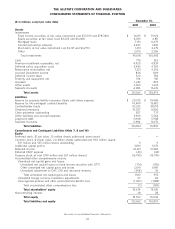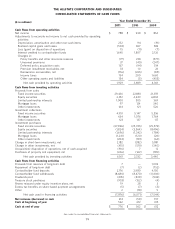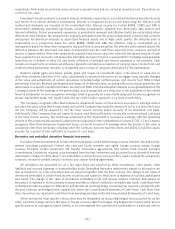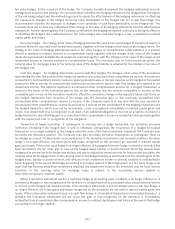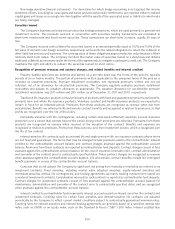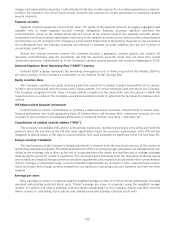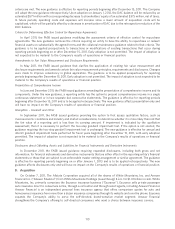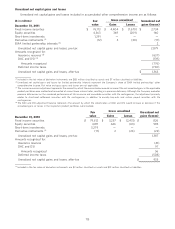Allstate 2012 Annual Report Download - page 193
Download and view the complete annual report
Please find page 193 of the 2012 Allstate annual report below. You can navigate through the pages in the report by either clicking on the pages listed below, or by using the keyword search tool below to find specific information within the annual report.testing during the fourth quarter of each year based upon data as of the close of the third quarter. The Company also
reviews goodwill for impairment whenever events or changes in circumstances, such as deteriorating or adverse market
conditions, indicate that it is more likely than not that the carrying amount of goodwill may exceed its implied fair value.
To estimate the fair value of its reporting units, the Company may utilize a combination of widely accepted valuation
techniques including a stock price and market capitalization analysis, discounted cash flow calculations and peer
company price to earnings multiples analysis. The stock price and market capitalization analysis takes into
consideration the quoted market price of the Company’s outstanding common stock and includes a control premium,
derived from historical insurance industry acquisition activity, in determining the estimated fair value of the
consolidated entity before allocating that fair value to individual reporting units. The discounted cash flow analysis
utilizes long term assumptions for revenue growth, capital growth, earnings projections including those used in the
Company’s strategic plan, and an appropriate discount rate. The peer company price to earnings multiples analysis
takes into consideration the price earnings multiples of peer companies for each reporting unit and estimated income
from the Company’s strategic plan.
Goodwill impairment evaluations indicated no impairment as of December 31, 2011 or 2010.
Property and equipment
Property and equipment is carried at cost less accumulated depreciation. Included in property and equipment are
capitalized costs related to computer software licenses and software developed for internal use. These costs generally
consist of certain external payroll and payroll related costs. Certain facilities and equipment held under capital leases are
also classified as property and equipment with the related lease obligations recorded as liabilities. Property and
equipment depreciation is calculated using the straight-line method over the estimated useful lives of the assets,
generally 3 to 10 years for equipment and 40 years for real property. Depreciation expense is reported in operating costs
and expenses. Accumulated depreciation on property and equipment was $2.29 billion and $2.41 billion as of
December 31, 2011 and 2010, respectively. Depreciation expense on property and equipment was $222 million,
$239 million and $256 million in 2011, 2010 and 2009, respectively. The Company reviews its property and equipment
for impairment at least annually and whenever events or changes in circumstances indicate that the carrying amount
may not be recoverable.
Income taxes
The income tax provision is calculated under the liability method. Deferred tax assets and liabilities are recorded
based on the difference between the financial statement and tax bases of assets and liabilities at the enacted tax rates.
The principal assets and liabilities giving rise to such differences are DAC, unrealized capital gains and losses on certain
investments, differences in tax bases of invested assets, insurance reserves and unearned premiums. A deferred tax
asset valuation allowance is established when there is uncertainty that such assets will be realized.
Reserves for property-liability insurance claims and claims expense and life-contingent contract benefits
The reserve for property-liability insurance claims and claims expense is the estimate of amounts necessary to
settle all reported and unreported claims for the ultimate cost of insured property-liability losses, based upon the facts
of each case and the Company’s experience with similar cases. Estimated amounts of salvage and subrogation are
deducted from the reserve for claims and claims expense. The establishment of appropriate reserves, including reserves
for catastrophes, is an inherently uncertain and complex process. Reserve estimates are regularly reviewed and updated,
using the most current information available. Any resulting reestimates are reflected in current results of operations.
The reserve for life-contingent contract benefits payable under insurance policies, including traditional life
insurance, life-contingent immediate annuities and voluntary accident and health products, is computed on the basis of
long-term actuarial assumptions of future investment yields, mortality, morbidity, policy terminations and expenses.
These assumptions, which for traditional life insurance are applied using the net level premium method, include
provisions for adverse deviation and generally vary by characteristics such as type of coverage, year of issue and policy
duration. To the extent that unrealized gains on fixed income securities would result in a premium deficiency if those
gains were realized, the related increase in reserves for certain immediate annuities with life contingencies is recorded
net of tax as a reduction of unrealized net capital gains included in accumulated other comprehensive income.
Contractholder funds
Contractholder funds represent interest-bearing liabilities arising from the sale of products such as interest-
sensitive life insurance, fixed annuities, bank deposits and funding agreements. Contractholder funds primarily comprise
deposits received and interest credited to the benefit of the contractholder less surrenders and withdrawals, mortality
107


